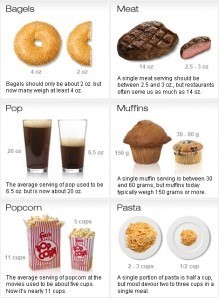Katja Rowell's Blog, page 6
March 27, 2013
When Feeding Therapy Becomes Aversion Therapy
I was happy that the Huffington Post put out my essay on what I believe are harmful feeding therapies. Let me know what you think, and feel free to share, comment etc. This is a discussion that needs to happen!
Huffington Post, When Feeding Therapy Becomes Aversion Therapy
March 26, 2013
quick tip video: helping kids with family-style
learning how to cook, variations on a theme
I was so blown away by this comment on a recent blog post that I decided to make sure it didn’t get lost. It is a must read as far as I am concerned, in terms of teaching yourself to cook, and taking care of yourself… My only complaint is that I would disagree that this reader says her cooking skills are nothing special! I repost with permission, and gratitude as I head off to the Mall of America for some Spring Break fun before a few hours work this afternoon! (M has been begging for Build a Bear for a year, so this will be our entertainment, followed by lunch at her favorite Chinese buffet. She’s been more excited about the Bear than her recent cruise with her grandparents, so I’m going to enjoy it, even if we could use another stuffed animal like a hole in the head…)
Readers, how did you learn/teach yourself to cook?
“… I am neither a confident nor a talented cook (I’m a strict recipe follower), and I’m not a foodie either – not particularly adventurous, food is fuel more than anything else, etc. (I’m not saying that’s better than any other approach, just the way I’m wired and always have been). My dinner-cooking and ability to provide edible food for myself turned a corner when I mastered about half a dozen simple meals in the kitchen, and now I can do at least half a dozen variations on each of them… They are:
– a simple red or green curry with two main ingredients (tofu & broccoli, pumpkin & chickpea, etc).
– a stir-fry (teriyaki, peanut satay, oyster sauce, etc etc, with different greens)
– a stuffed baked potato or sweet potato
– a quinoa salad, with various pairings (a Greek version, a Japanese version, etc)
– a simple vegetable soup (can do pumpkin/carrot/sweet potato/pea/etc)
- a Mexican bowl (basically nachos/tacos/etc ingredients on rice and beans rather than chips or shells)
All of these things are cost effective (and guaranteed to work) and vegetarian. It sounds like quite a bit, and sure it took time to learn each of those skills, but I genuinely do only know how to cook six things (and then variations on each one). I’m perfectly satisfied with the amount of variety I get, and I can now cook each of those things fairly quickly. And they taste really good!! It’s so much more successful than when every night was Russian Roulette – trying a salad I’d never made before, trying to do homemade pizzas one night and pasta sauce the next… It was so stressful, and I really couldn’t afford (timewise or financially… I’m a young journalist, so I get paid like crap) to have any mishaps (which I frequently did). I try and ensure I get all my nutritional needs by being adventurous with my grains/legumes/veggies/meat-free proteins that accompany each dish – but that’s only taking a gamble on one ingredient, and I know I’ll get the sauce right.
Now that being in the kitchen every night doesn’t end in stress and tears (and I don’t even have kids, that’s just me!! Lol), I feel less pressured when I am actually trying something new… My current things I’m working on (to take the list up to 8!) are risotto and lentil stew (again, quite flexible dishes). But I know I can try them once a week, end up eating toast, and still get it right the other days. The other thing that has helped has been containing my experimentation and learning new skills to baking/sweet treats. It’s OK if I mess up the cupcakes, because they’re not essential to my nutrition, and I only buy ingredients for sweets if I can afford them (knowing they don’t form part of my core nutrition, and that nothing might come of them). It’s so much less stressful to balls up a cake than your dinner.
I know this probably sounds a bit pathetic (also, long!!) but just wanted to reiterate that there are people out there who really have struggled in this situation. I grew up poor and in a single parent family (father only), so lived on pot noodles, toast, chicken nuggets, etc, and was never taught to cook (no classes at school either). So I only started myself at 18, and it’s taken me til my 20s to get to the level of confidence/proficiency I’m at now (still not great I know, but I’m happy enough). I don’t even remember how I realized that learning a few things and then swapping the ingredients around was the way to go… Maybe it was dating a guy who cooked green curry about 4 times a week, haha.”
March 21, 2013
what it really means to “offer” food
 I wrote recently about how important it is to offer foods over and over, to (re)introduce children to variety in flavor and texture.. Later that day, I watched a video on picky eating of a mom “offering” her child options. She stood at the fridge asking, “Do you want noodles? Do you want rice? Do you want cucumbers?” His answer of course to each offer was, “No.” Was this mom really “offering” choices? I think she would say she was…
I wrote recently about how important it is to offer foods over and over, to (re)introduce children to variety in flavor and texture.. Later that day, I watched a video on picky eating of a mom “offering” her child options. She stood at the fridge asking, “Do you want noodles? Do you want rice? Do you want cucumbers?” His answer of course to each offer was, “No.” Was this mom really “offering” choices? I think she would say she was…
I realized that it might help to clarify what “offer” means. There are ways to offer foods that will increase the chance of your child branching out, and there are ways to “offer” that will invite almost immediate and certain refusal. There are even ways to offer that cross into pressure, which may invite push-back and increasing anxiety—the enemy to supporting competent eating…
When “offer” isn’t really “offering” and why it matters.
Increasingly, I am hearing from parents of more extreme picky eaters who tell me they “offer” a variety of foods “all the time.” I do wonder if the offering isn’t often much like the mom in the video above?
I think we have to really be clear, and brutally honest. Because I know many parents think they offer foods, but aren’t often making it truly easy for the child to choose to say yes. Studies show that most parents give up on new foods after three tries. Many parents of infants are pretty poor at actually knowing what foods a child does and doesn’t “like” (see the green bean study). Many parents simply don’t offer foods after initial rejection, thinking the child “doesn’t like” them. My favorite example of this was the client with three boys, with the middle son, age 4, being the most selective eater. When brainstorming about protein, I wondered about shrimp. Mom answered, “Oh no, they don’t like shrimp.” Dad looked at Mom, then at me, “We’ve lived in this house for five years, and we’ve never had shrimp.” In fact her two youngest sons had never been offered shrimp… It’s complex you see.
Take the mom of the child who eats less then ten foods that I talked with recently. She serves him his dinner at the kitchen island with 2-3 of his accepted foods. There are no other choices available set out. She sometimes asks him while preparing his meal if he wants something else. The “offer” is always rejected. Then later, Mom and Dad eat their food at the kitchen table.
What does an honest, no-pressure, make it easy to be brave, low obstacle “offer” look like?
Takes place in a pleasant family meal where the parents are enjoying the foods on offer (without comments, bribes or praise).
There is room on the plate, or an extra plate or bowl where the child can put the food.
There is a paper napkin nearby where the child can spit out the food.
The food is within reach, but not placed or pushed onto the child (see post on where to place foods).
Avoid thinking of foods in terms of what they “like” or “don’t like.” Kids are fickle, and what they reject one day, or month, they will for no reason pick up again, but they have to see the food again…
The child has to have time to throw out the first rejection, or push back, and be met with no resistance, pressure or attempts to convince or coerce. The initial reaction of most children, not just those with sensory issues is “no.” Wait it out (post on waiting out the initial rejection)
There must be no pressure to try, or kiss, play with, lick or interact with the food in any way.
What do you think? Are you really offering a variety of foods? (I had a recent reminder to do this at my own table…) It was around scrambled eggs. Had I asked her if she wanted any, she would have said no, but when I caught myself and put some in the middle of the table, and gave her an extra plate (all without comment) she went on to help herself to a few bites of egg…
March 19, 2013
building on what your child already likes, bridges for picky eaters
 I talk to parents about this all the time, but had my own recent reminder…
I talk to parents about this all the time, but had my own recent reminder…
If your child likes a food, find something similar to offer. If it’s a flavor, a sauce, or a food prep technique, be mindful of using or including that familiar characteristic, making that link to new foods… (This notion of “chaining” or “bridging” similar tastes is common in the selective eating and sensory world.) Don’t forget that all the bridging won’t work if you are still battling over eating. Key is to offer the food in a pleasant, neutral way, as part of meals and snacks. And avoid praise if your child tries it…
Yogurt: M is not a breakfast food kind of kid. She recently started eating peach Fage 2% Greek yogurt, refusing other flavors that I enjoy like blueberry and strawberry. I have also offered Stonyfield Smoothies before, the flavor I like, which is the mixed berry. I’d be happy to include more yogurt and the smoothie drinks to help round out breakfasts and snacks on the go.
So, it finally hit me. I’ll try offering peach flavored smoothie, and I can enjoy them if she doesn’t. I offered the smoothie with snack the other day. She tried a sip, said, “Ew, I don’t like it!” and walked away. Ten seconds later, she tried another sip. Then drank about half the bottle.
I made no comment, and I enjoyed the other half with my lunch the next day.
M is overall an adventurous eater, but this scenario helps illustrate a few things:
the initial reaction is usually negative to a new food
wait… don’t rationalize, or try to sell the smoothie (as in, “But the peach is like the yogurt you like, you’ll like it!)
familiar flavors can be the bridge to new foods
Have you seen this work?
March 14, 2013
teach kids to use the “f-word”
 Part of my mission is to help kids feel good about food AND their bodies. This post is about helping children develop positive body image, and avoid fat bias. (Caillou is one of the few shows I’ve found that shows positive body diversity.)
Part of my mission is to help kids feel good about food AND their bodies. This post is about helping children develop positive body image, and avoid fat bias. (Caillou is one of the few shows I’ve found that shows positive body diversity.)
This question recently made it’s way to my inbox…
“I don’t know how to talk to my preschooler about fat people. When reading a story where a character is described as ‘the fat man’ I change it to ‘the big man’ simply because I don’t want her using the word fat to describe people because she’s 3 and 3 y.o.’s aren’t the best at using words in appropriate ways. A few months ago at a birthday party she asked an acquaintance of mine “Why are your arms SO FAT?” I pretended I didn’t hear and then continued to tie her shoes. The acquaintance responded back with a joke of “Why are you sooo skinny?” Then more recently my daughter put a small pillow on her belly and said “Look I’m a fat girl!” Then when she got tired of being ignored she started singing the words over and over. Until we told her to stop singing that and pick a different song. I just don’t know how to respond. I don’t want the word ‘fat’ to be bad or taboo…what would you say?”
With a seven year-old of my own, we continue to navigate this issue in a culture that is increasingly fat-biased (think The War On….). The word “fat” is associated with horrible things; like being lazy, stupid, mean, more likely to steal etc. (And these impressions are from polling preschoolers.) When I read essays by fat activists, who themselves are fat, they talk about how strange it is when friends say, “But you’re not fat!” “I am fat,” they reply, but not all those things people associate with being fat… (Here is Kate Harding’s example...)
Fat is a descriptor, but it has been taken over as an insult, a shameful word. I love how your friend answered your daughter’s innocent remark. If you were right there you could even add, “Yes, my arms are fatter than yours, and Daddy has skinny arms too!” Your friend didn’t seem to feel it was inappropriate, now the rest of society gets to catch up. 
When we treat ‘fat’ as a taboo word and topic, then if our children happen to be fat, gaining weight before the pubertal height growth, or fatter than peers (many “normal” children feel “fat” when compared to smaller peers), they will feel shame. Our lean children will also internalize that fear and shame of becoming fat. Either way it’s not good, and bound to make our children less happy, less active, more likely to diet and gain weight… What if a parent or loved one is fat? I imagine that brings up more embarrassment and conflicted feelings.
Reclaim the F-word. Be patient with yourself.
It took me a long time to get comfortable using the word ‘fat,’ so know that this will feel hard. We’ve been taught that to use the word ‘fat’ is not polite, it is mean and can hurt someone’s feelings, because most often anymore, that is how it is intended. Polite folks might say, “curvy,” “stout,”"chubby,” or “big.” I remember as I began reading about fat acceptance, and challenging myself to use the f-word, finding it very awkward and scary. Even now, when I give workshops, I talk about how I use the word “fat,” and why, because I know some folks in the audience may think I’m just being rude…
You will have plenty of practice learning to get comfortable with this word. I think I’m there, but it’s taken years. Here’s how I’ve handled it.
Tall, lean, skinny, fat, round, short, thick…
These are all physical descriptors— just like having straight or curly hair, brown or pink skin. From a very young age, I peppered the word “fat” into conversations as appropriate. I did not flinch from the word when used as a neutral descriptor. I did not correct her words when she pointed out someone who was “fat” at the store. We did talk about not pointing at anyone, or talking about people in general, since it’s rude, but if we were out for a walk and she saw a fat person and commented, I might say something like:
“Yes, she is fat, and tall. I like her curly red hair—reminds me of Brave!” On another occasion, “Yes, I’m fatter than Auntie I, Daddy is fatter than me…”
Other examples of how I re-frame “fat” and undo the brainwashing
On a bike outing last fall, I noted that we were being passed by all kinds of people; thin, fat, old, young, black, white, and I casually pointed this out. “Look at how crowded the bike path is! I like that we are biking with old and young people, thin and fat people.” If someone large passed us, I might comment about how fast they were going. It feels artificial sometimes and forced, but children are literally inundated with images and reminders of how fat people (or cartoon characters) are all lazy, unfit, greedy… I sometimes feel like I am undoing brainwashing and need to be proactive.
In her Montessori preschool, an older boy made up a song about a fat lady in a tree. At almost four, she sang it one morning and giggled. This was also when she started giggling whenever the word “fat” was read to her or mentioned. She was getting that the word “fat” was funny, a joke. I told her that the song was mean, and wrong. I talked to her, without shaming her, since she was learning fat bias at her lovely liberal little school, that “fat” is just a word, and I used it often as such. I talked to the teacher about the song. The teacher said, “We try not to use the word ‘fat.’” But, it is precisely our discomfort and treating it differently that makes it so powerful and shameful, and the kids pick up on this. I tried to educate the teacher as well, that I wasn’t objecting to the word ‘fat,’ but to the boy’s mocking song, and that the song needed to be stopped, not the f-word. I tried (fell on deaf ears) to make a case for actually reclaiming the word ‘fat.’
While watching Garfield, or reading Harry Potter, or consuming any entertainment full of fat bias, I often do change the words when I can, or change descriptors. When I can’t, I call it out. At 7, I use the word stereotype. “This is a stereotype. See how they talk about the fat boy in class being greedy and selfish, and mean?” I do the same thing for other instances of stereotypes, from gender at the toy-store aisle where the girls are sold princesses and make-up, to Disney movies around ethnicity. (I’m not always the most fun person to watch TV with, and I’ve banned the new Garfield TV show outright for outrageous fat bullying…)
Alas, I imagine I will have to acknowledge someday with my child that some people don’t like the word, and might feel hurt if we talk about fat. I will try to teach her not to comment on people’s bodies at all. (Actually I don’t really know what I’ll do about this right now, but maybe that’s another post!) I try to model not commenting on people’s bodies. I don’t greet friends with, “You look great!” I greet them with, “I’m so happy to see you!” I certainly don’t point fat people out as cautionary tales for eating veggies or exercising as I know some parents do…
Mostly, it boils down to this. Use the f-word, use it often, and point out fat-bias as is age appropriate. What do you think? Does this sound doable? Do you feel like I’m off base?
I’d love to hear from other parents. How do you handle this?
Update from FB, one mom summed it up better than I!
“The only thing I would say is that I want to define the word in my family so that I can help my child develop strategies for when people comment on him or his parents as fat – I don’t want the word to be hidden in the family and then only have the meaning that cruel children / tv ads / government health advisories give to it.”
March 11, 2013
Questions to ask your therapist before starting feeding therapies
 I am hearing from more and more parents who are not happy with feeding therapy. Or who have “failed” feeding therapies… I wrote chapter 3 and 4 in my book, Love Me, Feed Me, particularly for families with picky or problem eaters, and for parents who feel like feeding therapy isn’t helping. (It is also important to note that there is so much you can do to support healthy feeding whether you pursue therapy or not. Many parents feel the only option is therapy, or give in and serve chicken nuggets every night.)
I am hearing from more and more parents who are not happy with feeding therapy. Or who have “failed” feeding therapies… I wrote chapter 3 and 4 in my book, Love Me, Feed Me, particularly for families with picky or problem eaters, and for parents who feel like feeding therapy isn’t helping. (It is also important to note that there is so much you can do to support healthy feeding whether you pursue therapy or not. Many parents feel the only option is therapy, or give in and serve chicken nuggets every night.)
So many families are now being referred for feeding evals, and that is a mixed bag. This is an incredibly complex topic, which is why chapter 3 was the longest in my book. As a starting point, I have adapted a page of questions from my book to mull over as you consider therapy. If you are considering feeding therapy, my book may be a helpful resource, filled with stories from parents who had both good and bad experiences with formal therapy, as well as some parents who chose not to pursue therapies. As far as I know, it is the only resource of its kind, offering a “primer” of sorts, into diagnosis, treatment options, how to tell if what you are doing is helping or not. (I refer families to the book, with both biological and adopted children, since most of the content is the same for all families.)
As one mother said, “Bad therapy is worse than no therapy,” and I couldn’t agree more. As I hear horror stories from parents with children sobbing, gagging and vomiting daily through “therapy” tasks at the dinner table, I can only think that we have to do better.
Here is the content from a PDF you can download, which is on my resources page under PDFs. I have also added several others, from starting solids, to talking to kids about food. Feel free to print them off, share with teachers, friends, mothers-in-law…
Tell me what you think of this list of questions. Am I missing anything? What have your good or bad experiences been? Who was most or least helpful to you when dealing with your child’s feeding challenges?
Questions to Ask a Feeding Therapist
The right speech therapist or feeding team evaluation can be incredibly helpful, but a poor fit can slow down your child’s progress with eating. As one mom said, “Bad therapy is worse than no therapy.” If you are experiencing challenges, identifying your child’s baseline skills with eating, including chewing and tongue lateralization (the ability to move food from the front teeth to the sides and place in the correct position for chewing with molars), can help you provide foods that are safe, help your child progress with her eating, and help you feel confident and supported at home. Here are a few questions to think about as you look for the right help for your family, which may or may not include formal therapy. Remember to trust your gut. If what your therapist is asking you to do increases conflict or anxiety at the table, leads to more gagging or vomiting, it is likely to make matters worse, not better.
Qualifications/training:
How long have you worked with feeding specifically?
Have you completed your training and are you licensed? (I added this to the list after reading about a feeding clinic staffed entirely by OT students.)
What extra training or certification do you have with feeding?
Are you aware of the Trust Model of feeding, the Division of Responsibility, or ��Responsive Feeding?
Are you aware of the “Get Permission” approach from Marsha Dunn Klein? ��(Dunn Klein is a pediatric occupational therapist, author, and founder of Meal-time Notions.)
Were you exposed to a variety of feeding therapy approaches in your training? ��
Tell me about your training in feeding therapy? (I believe there is no standard training or certification outside of the state of California.)
Treatment Philosophies:
How do you help families integrate your advice in the home?
Will you separate me from my child or ask me to use my attention or lack thereof ��to motivate my child to eat?
What do you consider “successful” treatment? What criteria determine when ��treatment is “over?”
What resources do you recommend?
What can you offer if “therapy” meals or other suggested techniques result in ��conflict or a power struggle?
Do you show disapproval or hold food in front of the child’s mouth until she ��gives in?
Do you use external rewards like stickers or toys to motivate my child to eat?
Can I observe a treatment session or watch a video?Adapted from Rowell’s book Love Me, Feed Me. Chapter 3 focuses in detail on feeding challenges, sensory issues, and how to find the right help for your family. Chapter 4 goes into supporting eating in the home, or if your child has “failed” feeding therapies…
Katja Rowell M.D. 2012 www.thefeedingdoctor.com
March 7, 2013
mealtime theater: this time not so crazy, but a good reminder to offer offer offer!
 M is not a huge fan of eggs. It’s one of those foods she eats for awhile, then passes over for months on end. I made scrambled eggs the other morning “for” my husband and I, putting out cereal, milk and yogurt for my daughter. I caught myself before pre-plating the eggs directly onto our toast (we do breakfast a little differently than other meals) and remembered to put the eggs on a plate in the middle of the table, with a plate for M in case she wanted some. (Without comment.)
M is not a huge fan of eggs. It’s one of those foods she eats for awhile, then passes over for months on end. I made scrambled eggs the other morning “for” my husband and I, putting out cereal, milk and yogurt for my daughter. I caught myself before pre-plating the eggs directly onto our toast (we do breakfast a little differently than other meals) and remembered to put the eggs on a plate in the middle of the table, with a plate for M in case she wanted some. (Without comment.)
We settled in, I helped myself to some eggs, M started with cereal. I offered her eggs, she said, “No thank you,” and we moved on.
We’re chatting away, and at some point I say, (because it was true, not to try to make her eat eggs), “These eggs are really hitting the spot. Mmm.”
A few minutes later (not right away), M reaches out and takes a few small hunks of eggs and sprinkles some salt on them and eats them. She then eats the rest of her cereal.
It was such a powerful reminder for me, yes, even when I live and breathe this stuff at home and work, I forget…
Make it easy for a child to take a food—it was in reach, she had a plate. If I hadn’t remembered to do that, the barrier of getting a new plate would have likely been enough to make her pass.
Offer, and calmly take no for an answer.
Wait… don’t whisk the eggs away or finish off the plate. Time and again after initially refusing a food, within a few minutes she might try some or take it. (I hear this from parents all the time.)
Don’t offer opportunities for kids to reject food or have to take a stand (pre-plating, arguing that she liked them last time, or used to like them…)
There is no need to oversell a food, offer repeatedly etc. This in fact will turn many kids off.
Be honest and watch for the agenda. Having been at this for awhile, I trust she’ll come back to eggs, or not, on her own time frame. I can share my authentic pleasure and joy with food when my motivation is about that, sharing pleasure, not getting her to eat more.
What do you think? Have you seen this at work at your table?
If you’re curious, search for “Crazy mealtime theater” for more anecdotes from my table with feeding lessons. Here are a few…
March 6, 2013
fun with food, in the snow
Yesterday was a snow day for most of Minnesota, except for St Paul and Minneapolis. We had 6-8 inches of snow, and I was thankful again that we live within walking distance of school! Snow in March is okay, snow in April is a bummer, so I was ready for another way to celebrate and enjoy the snow.
Luckily, a friend posted this fun video on facebook about how to make ice-cream from snow; so on the way to get M, I walked to the corner market and bought some half and half, and the strawberries looked decent, so I bought those too. We invited our friends to join us last minute, since making and sharing special food with others makes it even more fun and special.
We enjoyed our treat (I used a little less sugar than recommended), and we all remarked how different the texture was. It was a big hit, and a bit of a mess!
What fun have you had with food recently?
Remember, having kids participate in buying or making food makes it more likely that they will enjoy the food or try it, but it’s no guarantee, and try to avoid the pressure of, “You helped make it, aren’t you going to just try a little?” If you have a selective or sensory child, any positive experience with food is a win.
March 5, 2013
"It’s all about portion control" or is it… Talking about DOR
 “I’m a registered dietitian, I have two small children (who eat totally different from each other, one picky, one adventurous), and I support and practice the DOR. I have been having some pretty heated (ok, it’s probably just me) conversations with some of my coworkers (not dietitians) about the feeding relationship. I feel like in trying to describe the DOR, I end up getting defensive and maybe a bit pedantic. Any advice would be greatly appreciated. ” -facebook question
“I’m a registered dietitian, I have two small children (who eat totally different from each other, one picky, one adventurous), and I support and practice the DOR. I have been having some pretty heated (ok, it’s probably just me) conversations with some of my coworkers (not dietitians) about the feeding relationship. I feel like in trying to describe the DOR, I end up getting defensive and maybe a bit pedantic. Any advice would be greatly appreciated. ” -facebook question
This made me think of the conversations I have when people find out that I am a childhood feeding specialist, helping parents with weight concerns, among other things. Almost always, the person I am chatting with launches into explanations for the “obesity epidemic,” you see, we all know, “it’s the portions!” (Or High Fructose Corn Syrup, or not enough recess, or lazy parents, or the food industry…) Picky eating? They inform me it’s just “parents who don’t know how to cook,” or who are “too permissive…”
It’s a unique experience to be well-read and versed on research and clinical experiences and then to have everyone think they know the answers. I imagine bridge builders don’t have the same experience… “Oh, you’re a bridge builder! You know, the problem with all these bridges falling apart is that you need a wider base to hold them up with, we all know that!”)
First off, for new readers, DOR is the Division of Responsibility, which basically says that if parents do their jobs with feeding: provide variety of tasty foods, structure, family meals, no pressure, then children can be trusted to decide how much to eat from what is provided.
It trusts that humans are capable of self-regulation. And this is where people get stuck.
Many Americans think, “Humans are not capable of self-regulation, and if we don’t teach kids portion control, who will?” (This is a literal quote from a feeding therapy trainer to a room full of OTs and STs, who are the ones “teaching” kids to eat in feeding therapy sessions, and not one person challenged that statement. I’ve also heard pediatricians and others say that humans can’t self-regulate.)
Here is what we all “know”: fat kids are fat because they eat too much, skinny kids need to eat more… The DOR does not accept this. It accepts that even children growing in a healthy way at the extremes can be trusted to self-regulate, and therefore is totally antithetical to how most people think about food, feeding etc. Which is, “it’s all about portion control”, and, kids can’t self-regulate so we have to do it for them. If you can’t trust that kids can self-regulate, then you can’t trust them to do their jobs, and you can’t do the DOR.
The first question came in just after I tried to explain to a Dad in the park that it’s not all about portions, at least not the way he thinks it is. But let’s say that some people eat lots more than they need to, well beyond satiety, and some do. Here’s how I approach talking to folks about the model I work in, and note, this is a work in progress!
1) I accept that I won’t convince anyone of anything in one brief chat.
2) I often share how I used to believe in “portion control” or calories in, calories out, but I saw that it didn’t work with my patients and it didn’t work for my family. “You know, I used to think so too, but after spending a few years reading, seeing it work in my own home, and transform the lives of my clients, I’m pretty convinced…”
3) I acknowledge that it took two good years of reading the research to convince myself that the Trust Model is the way to go. I also acknowledge that every experience, interaction and study I’ve read since then has strengthened this conviction.
4) I acknowledge that some folks eat beyond full, and I suggest that culturally we actually train children to do so. 85-90% of Americans feed their children with the control model, which most often for young children means asking them to eat more, take two more bites, and not believe them when they say they are full. So, in essence, we teach children, who are BORN with the ability to self-regulate, to overeat. We teach them through clean-plate rules, or veggies and protein before dessert rules, to eat for reasons other than the signals coming from inside their bodies.
So, the answer is not to impose arbitrary portion limits, diets or restricting. I tell folks that we’ve tried that, FOR DECADES, and it’s not working. The answer is to help people learn to get back in touch with cues of fullness and satiety. To feed themselves well, with foods that taste good, at regular intervals—not to diet.
I find a few phrases helpful:
“We’re working really hard to get kids to be good eaters, to get them to eat more or less, or different foods, and most of our efforts make things worse.”
“How is what you are doing now working for you?”
“It doesn’t have to be so hard.”
“Kids are born with a wisdom, knowing how much to eat. Is it about portions? Maybe, but only because the way we feed kids in America trains many children to overeat. We can either feed kids in a way that supports their internal skills, or we can feed them in a way that suppresses and buries those cues of hunger and fullness.”
I hope that helps get you thinking some more. Would love to hear what you have tried…
Thanks for writing in and fighting the good fight! Part of why I wrote my book, Love Me, Feed Me, is to explain all this to parents and professionals in an accessible way.






